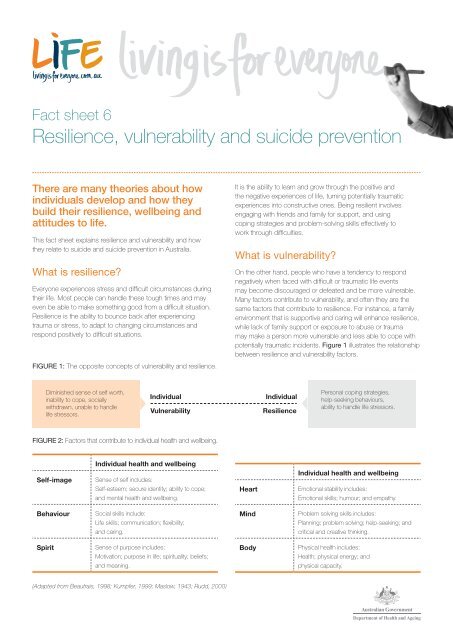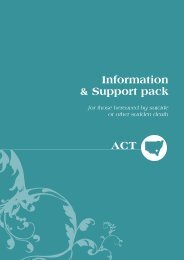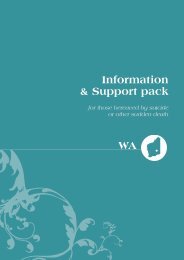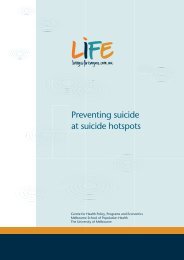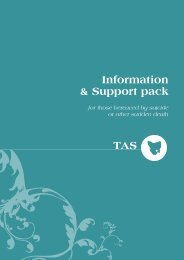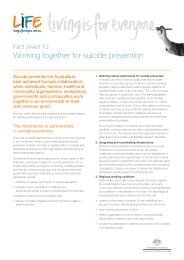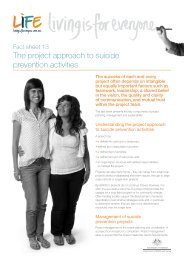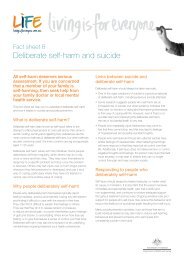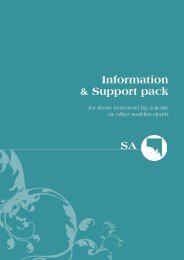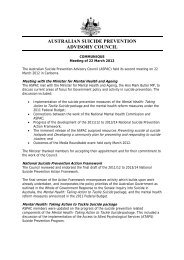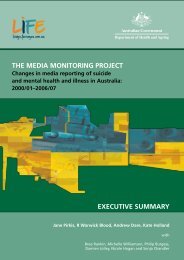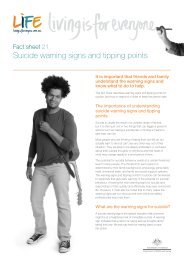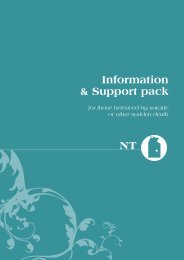Resilience, vulnerability and suicide prevention - One Life
Resilience, vulnerability and suicide prevention - One Life
Resilience, vulnerability and suicide prevention - One Life
You also want an ePaper? Increase the reach of your titles
YUMPU automatically turns print PDFs into web optimized ePapers that Google loves.
Fact sheet 6<br />
<strong>Resilience</strong>, <strong>vulnerability</strong> <strong>and</strong> <strong>suicide</strong> <strong>prevention</strong><br />
There are many theories about how<br />
individuals develop <strong>and</strong> how they<br />
build their resilience, wellbeing <strong>and</strong><br />
attitudes to life.<br />
This fact sheet explains resilience <strong>and</strong> <strong>vulnerability</strong> <strong>and</strong> how<br />
they relate to <strong>suicide</strong> <strong>and</strong> <strong>suicide</strong> <strong>prevention</strong> in Australia.<br />
What is resilience<br />
Everyone experiences stress <strong>and</strong> difficult circumstances during<br />
their life. Most people can h<strong>and</strong>le these tough times <strong>and</strong> may<br />
even be able to make something good from a difficult situation.<br />
<strong>Resilience</strong> is the ability to bounce back after experiencing<br />
trauma or stress, to adapt to changing circumstances <strong>and</strong><br />
respond positively to difficult situations.<br />
Figure 1: The opposite concepts of <strong>vulnerability</strong> <strong>and</strong> resilience.<br />
It is the ability to learn <strong>and</strong> grow through the positive <strong>and</strong><br />
the negative experiences of life, turning potentially traumatic<br />
experiences into constructive ones. Being resilient involves<br />
engaging with friends <strong>and</strong> family for support, <strong>and</strong> using<br />
coping strategies <strong>and</strong> problem-solving skills effectively to<br />
work through difficulties.<br />
What is <strong>vulnerability</strong><br />
On the other h<strong>and</strong>, people who have a tendency to respond<br />
negatively when faced with difficult or traumatic life events<br />
may become discouraged or defeated <strong>and</strong> be more vulnerable.<br />
Many factors contribute to <strong>vulnerability</strong>, <strong>and</strong> often they are the<br />
same factors that contribute to resilience. For instance, a family<br />
environment that is supportive <strong>and</strong> caring will enhance resilience,<br />
while lack of family support or exposure to abuse or trauma<br />
may make a person more vulnerable <strong>and</strong> less able to cope with<br />
potentially traumatic incidents. Figure 1 illustrates the relationship<br />
between resilience <strong>and</strong> <strong>vulnerability</strong> factors.<br />
Diminished sense of self worth,<br />
inability to cope, socially<br />
withdrawn, unable to h<strong>and</strong>le<br />
life stressors.<br />
Individual<br />
Vulnerability<br />
Individual<br />
<strong>Resilience</strong><br />
Personal coping strategies,<br />
help-seeking behaviours,<br />
ability to h<strong>and</strong>le life stressors.<br />
Figure 2: Factors that contribute to individual health <strong>and</strong> wellbeing.<br />
Self-image<br />
Individual health <strong>and</strong> wellbeing<br />
Sense of self includes:<br />
Self-esteem; secure identity; ability to cope;<br />
<strong>and</strong> mental health <strong>and</strong> wellbeing.<br />
Heart<br />
Individual health <strong>and</strong> wellbeing<br />
Emotional stability includes:<br />
Emotional skills; humour; <strong>and</strong> empathy.<br />
Behaviour<br />
Social skills include:<br />
<strong>Life</strong> skills; communication; flexibility;<br />
<strong>and</strong> caring.<br />
Mind<br />
Problem solving skills includes:<br />
Planning; problem solving; help-seeking; <strong>and</strong><br />
critical <strong>and</strong> creative thinking.<br />
Spirit<br />
Sense of purpose includes:<br />
Motivation; purpose in life; spirituality; beliefs;<br />
<strong>and</strong> meaning.<br />
Body<br />
Physical health includes:<br />
Health; physical energy; <strong>and</strong><br />
physical capacity.<br />
(Adapted from Beautrais, 1998; Kumpfer, 1999; Maslow, 1943; Rudd, 2000)
The importance of individual health<br />
<strong>and</strong> wellbeing<br />
From birth, everyone develops their sense of self <strong>and</strong> their<br />
unique ways of coping with life. Figure 2 summarises the essential<br />
characteristics for health <strong>and</strong> wellbeing that strengthen the<br />
individual <strong>and</strong> prepare them for life’s challenges. External factors<br />
<strong>and</strong> experiences such as family life <strong>and</strong> social interactions also<br />
influence a person’s reaction to difficult circumstances.<br />
Accumulated experiences from the past (cultural, social, family),<br />
<strong>and</strong> anticipation of the future (expectations, hopes, dreams <strong>and</strong> fears)<br />
all affect the individual’s ability to manage the range of<br />
events that can occur throughout life. These external factors can<br />
be summarised into four broad areas as illustrated in Figure 3.<br />
Figure 3: The four main factors that influence a person’s<br />
reaction to life events.<br />
Individual health<br />
<strong>and</strong> wellbeing<br />
Predisposing or<br />
individual factors<br />
<strong>Life</strong> history <strong>and</strong><br />
experience<br />
Social <strong>and</strong><br />
community<br />
support<br />
Sense of self; social skills; sense of<br />
purpose; emotional stability; problem<br />
solving skills; <strong>and</strong> physical health.<br />
Genes, gender <strong>and</strong> gender identity;<br />
personality; ethnicity/culture; socioeconomic<br />
background; <strong>and</strong> social/<br />
geographic inclusion or isolation.<br />
Family history <strong>and</strong> context; previous<br />
physical <strong>and</strong> mental health; exposure<br />
to trauma; past social <strong>and</strong> cultural<br />
experiences; <strong>and</strong> history of coping.<br />
Support <strong>and</strong> underst<strong>and</strong>ing from family,<br />
friends, local doctor, local community,<br />
school; level of connectedness; safe<br />
<strong>and</strong> secure support environments; <strong>and</strong><br />
availability of sensitive professionals/carers<br />
<strong>and</strong> mental health practitioners.<br />
How to increase individual resilience<br />
• Look after relationships. Family <strong>and</strong> close friends are usually<br />
willing to listen, provide support <strong>and</strong> often have helpful ideas<br />
or know where to go for help in all sorts of situations.<br />
• Think well of yourself. Identify what you are good at, <strong>and</strong> what<br />
you need to learn, to help you face the future. Invest time <strong>and</strong><br />
energy in developing new skills.<br />
• Practice helpful ways of thinking. Challenge negative thoughts<br />
<strong>and</strong> look for alternative solutions to problems, to find optimistic<br />
ways of viewing any situation.<br />
• Maintain health. Look after your physical health. Poor diet <strong>and</strong><br />
lack of exercise may contribute to negative thinking.<br />
• Develop a sense of connectedness. Get involved in enjoyable<br />
community activities such as social or sporting activities or<br />
volunteering; it will help to broaden social networks <strong>and</strong> counter<br />
any feelings of isolation.<br />
• Don’t tackle major problems alone. Ask for help <strong>and</strong> support<br />
when you need it, don’t be afraid of expressing your emotions<br />
<strong>and</strong> offer assistance in turn to those around you.<br />
How to build community resilience<br />
• Build community cohesion. Communities that work together<br />
<strong>and</strong> work towards common goals have a greater sense of<br />
optimism <strong>and</strong> morale.<br />
• Build stronger families. Community education programs<br />
can be helpful in improving skills in areas such as parenting,<br />
communication, relationships, money management,<br />
stress management <strong>and</strong> coping skills.<br />
• Develop cultural competency. Communities that value their<br />
cultural diversity can work more strongly together when times<br />
are hard. Education <strong>and</strong> training in cultural competency for key<br />
community members helps to ensure that the right support is<br />
available to everyone when they need it.<br />
• Build safe <strong>and</strong> healthy environments including lowering the<br />
threat of violence. Communities that are safe <strong>and</strong> secure<br />
are more likely to manage difficult circumstances positively.<br />
• Encourage healthy lifestyles. Promote regular physical<br />
exercise in the community by providing education <strong>and</strong><br />
awareness programs <strong>and</strong> access to bike or walking paths,<br />
parkl<strong>and</strong>s, <strong>and</strong> sport <strong>and</strong> other community facilities.<br />
More information<br />
• Bonanno GA (2004). Loss, Trauma, <strong>and</strong> Human <strong>Resilience</strong>.<br />
Have we underestimated the human capacity to thrive after<br />
extremely aversive events American Psychologist 59, 20-28.<br />
• Building <strong>Resilience</strong> to Stress (Employee Assistance) –<br />
resources <strong>and</strong> information on life cycle issues pertaining<br />
to work, family, mental health <strong>and</strong> personal life stresses:<br />
www.eap.partners.org<br />
• Glantz MD, Johnson JL (Eds.) (1999). <strong>Resilience</strong> <strong>and</strong><br />
Development: Positive <strong>Life</strong> Adaptations. Kluwer Academic/<br />
Plenum Publishers: New York.<br />
• Grotberg, EH (1995). A Guide to Promoting <strong>Resilience</strong> in<br />
Children: Strengthening the Human Spirit: The Bernard<br />
van Leer Foundation: The Hague.<br />
• Living Is For Everyone (LIFE) – A Framework for Prevention<br />
of Suicide in Australia (2007). Commonwealth Department<br />
of Health <strong>and</strong> Ageing: Canberra.<br />
• Living Is For Everyone (LIFE) – Research <strong>and</strong> Evidence in<br />
Suicide Prevention (2007). Commonwealth Department<br />
of Health <strong>and</strong> Ageing: Canberra.<br />
• Mental health & well being – information on the Australian<br />
Government’s role <strong>and</strong> contributions to mental health<br />
reform activities in Australia: www.mentalhealth.gov.au<br />
• Newman T (2004). What works in building resilience<br />
www.barnardos.org.uk<br />
• The Resiliency Center – information <strong>and</strong> resources about<br />
resilience: www.resiliencycenter.com<br />
• Siebert A (2005). The Resiliency Advantage. Master Change,<br />
Thrive Under Pressure, <strong>and</strong> Bounce Back from Setbacks.<br />
Practical Psychology Press.<br />
The Australian Government Department of Health <strong>and</strong> Ageing has financially supported the production<br />
of this document. While every effort has been made to ensure that the information contained is accurate<br />
<strong>and</strong> up-to-date at the time of publication, the department does not accept responsibility for any errors,<br />
omissions or inaccuracies. © Commonwealth of Australia 2007. This work is copyright. Apart from any<br />
use as permitted under the Copyright Act 1968, no part may be reproduced by any process without prior<br />
written permission from the Commonwealth. Requests <strong>and</strong> inquiries concerning reproduction <strong>and</strong> rights<br />
should be addressed to the Commonwealth Copyright Administration, Attorney-General’s Department,<br />
Robert Garran Offices, National Circuit, Barton ACT 2600 or posted at http://www.ag.gov.au/cca


